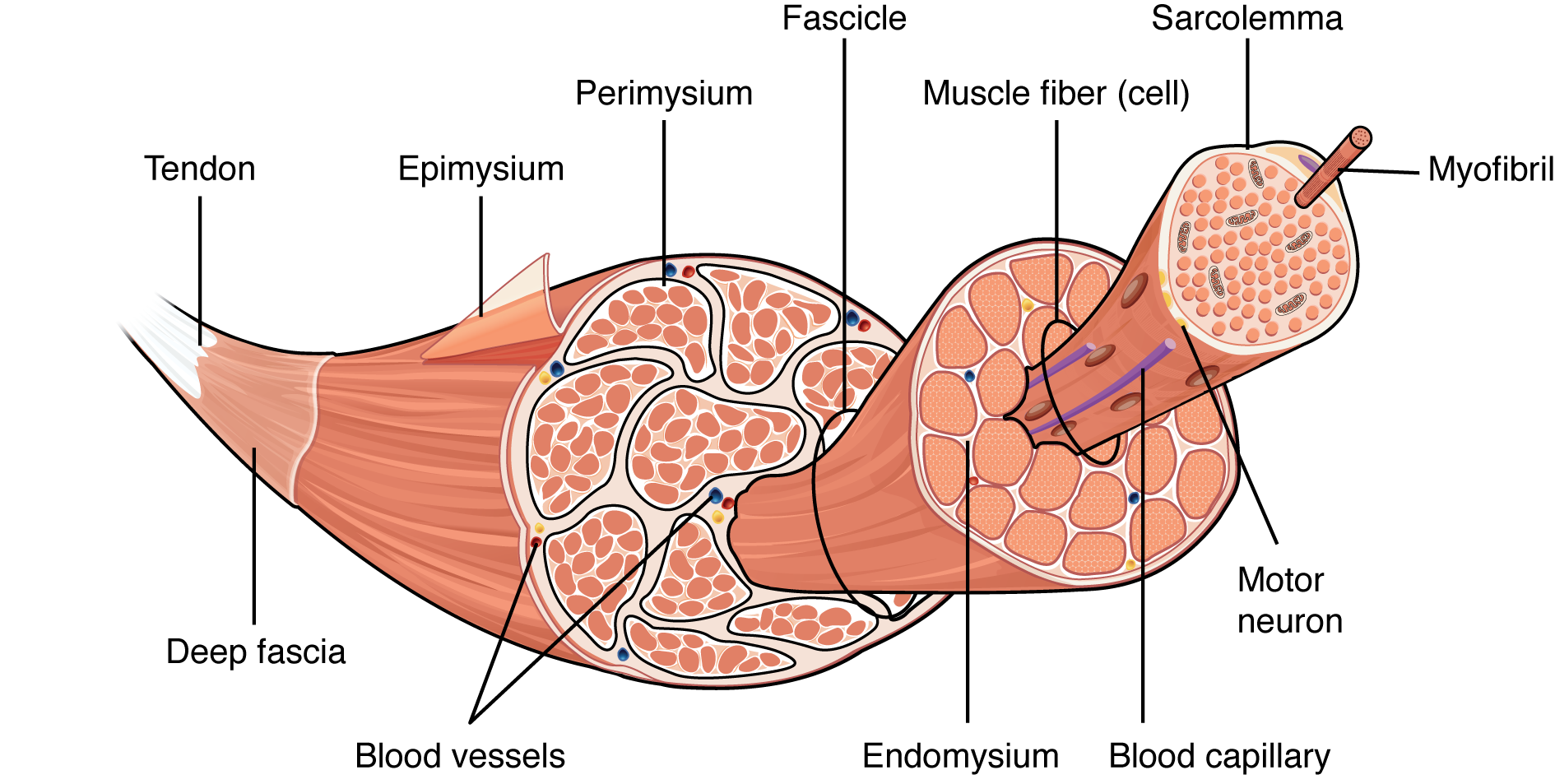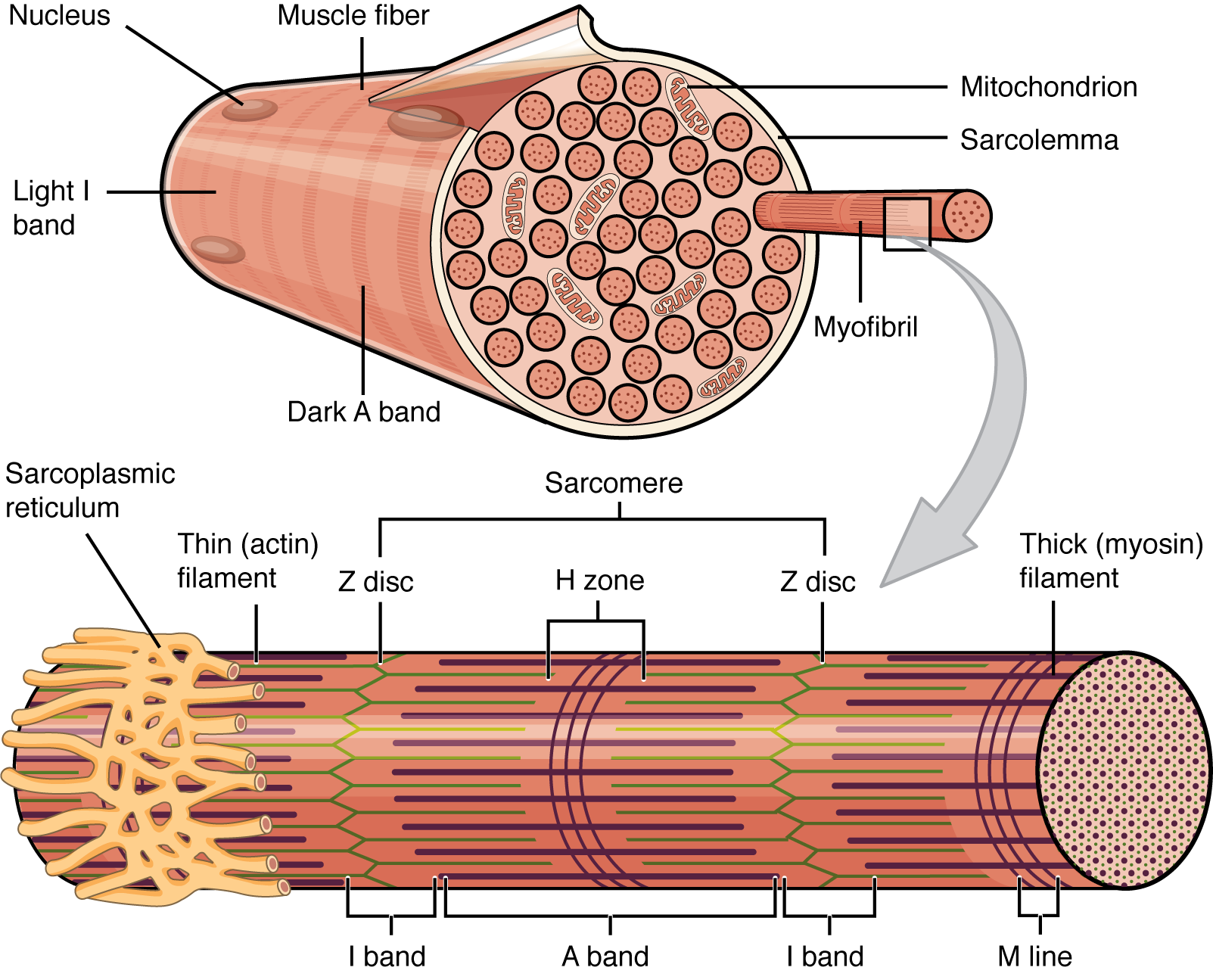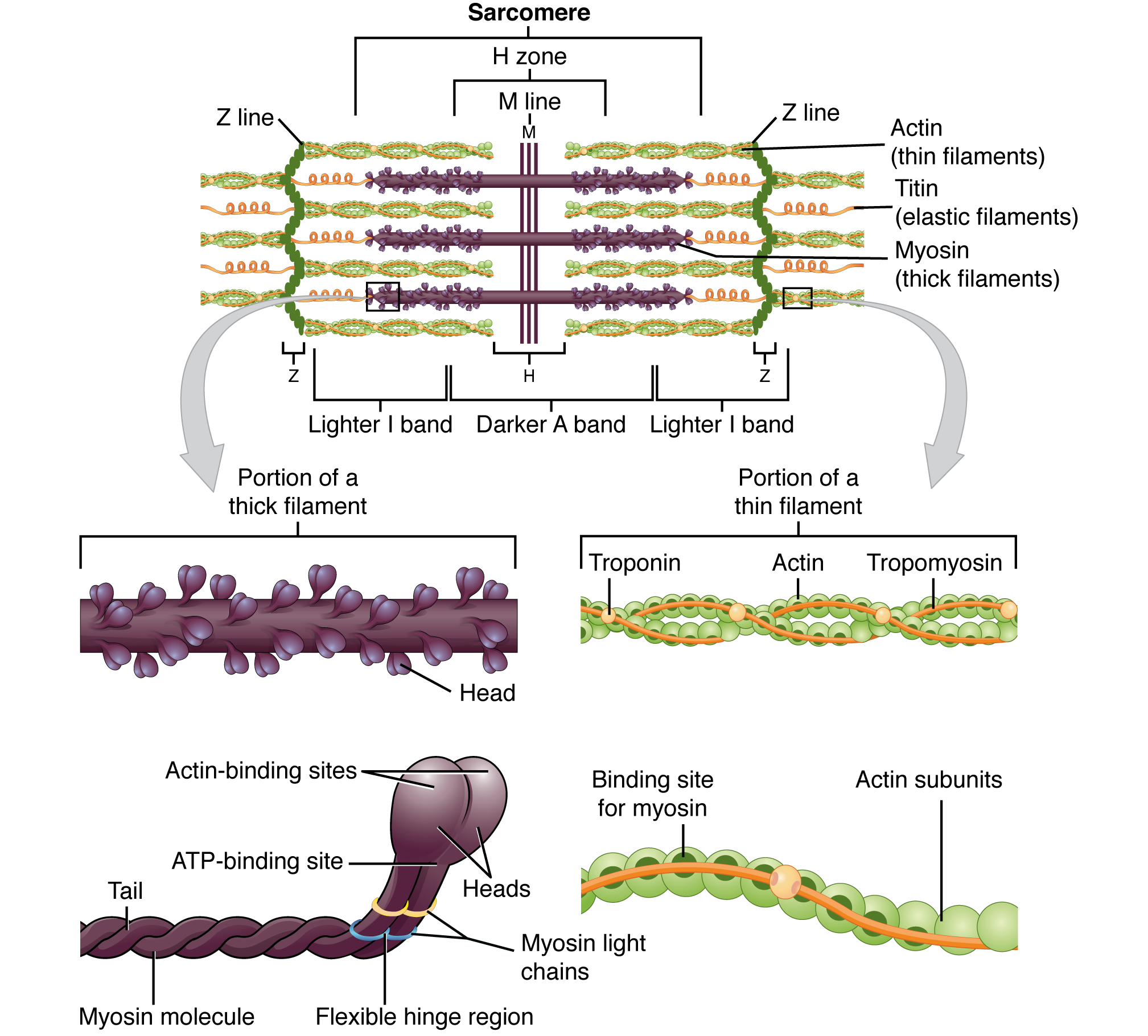
Each skeletal muscle is an organ that consists of various integrated tissues. These tissues include the skeletal muscle fibers, blood vessels, nerve fibers, and connective tissue. Each skeletal muscle has three layers of connective tissue (called mysia) that enclose it, provide structure to the muscle, and compartmentalize the muscle fibers within the muscle (Figure 10.2.1). Each muscle is wrapped in a sheath of dense, irregular connective tissue called the epimysium, which allows a muscle to contract and move powerfully while maintaining its structural integrity. The epimysium also separates muscle from other tissues and organs in the area, allowing the muscle to move independently.

Inside each skeletal muscle, muscle fibers are organized into bundles, called fascicles, surrounded by a middle layer of connective tissue called the perimysium. This fascicular organization is common in muscles of the limbs; it allows the nervous system to trigger a specific movement of a muscle by activating a subset of muscle fibers within a fascicle of the muscle. Inside each fascicle, each muscle fiber is encased in a thin connective tissue layer of collagen and reticular fibers called the endomysium. The endomysium surrounds the extracellular matrix of the cells and plays a role in transferring force produced by the muscle fibers to the tendons.
In skeletal muscles that work with tendons to pull on bones, the collagen in the three connective tissue layers intertwines with the collagen of a tendon. At the other end of the tendon, it fuses with the periosteum coating the bone. The tension created by contraction of the muscle fibers is then transferred though the connective tissue layers, to the tendon, and then to the periosteum to pull on the bone for movement of the skeleton. In other places, the mysia may fuse with a broad, tendon-like sheet called an aponeurosis, or to fascia, the connective tissue between skin and bones. The broad sheet of connective tissue in the lower back that the latissimus dorsi muscles (the “lats”) fuse into is an example of an aponeurosis.
Every skeletal muscle is also richly supplied by blood vessels for nourishment, oxygen delivery, and waste removal. In addition, every muscle fiber in a skeletal muscle is supplied by the axon branch of a somatic motor neuron, which signals the fiber to contract. Unlike cardiac and smooth muscle, the only way to functionally contract a skeletal muscle is through signaling from the nervous system.
Because skeletal muscle cells are long and cylindrical, they are commonly referred to as muscle fibers (or myofibers). Skeletal muscle fibers can be quite large compared to other cells, with diameters up to 100 μm and lengths up to 30 cm (11.8 in) in the Sartorius of the upper leg. Having many nuclei allows for production of the large amounts of proteins and enzymes needed for maintaining normal function of these large protein dense cells. In addition to nuclei, skeletal muscle fibers also contain cellular organelles found in other cells, such as mitochondria and endoplasmic reticulum. However, some of these structures are specialized in muscle fibers. The specialized smooth endoplasmic reticulum, called the sarcoplasmic reticulum (SR), stores, releases, and retrieves calcium ions (Ca ++ ).
The plasma membrane of muscle fibers is called the sarcolemma (from the Greek sarco, which means “flesh”) and the cytoplasm is referred to as sarcoplasm (Figure 10.2.2). Within a muscle fiber, proteins are organized into organelles called myofibrils that run the length of the cell and contain sarcomeres connected in series. Because myofibrils are only approximately 1.2 μm in diameter, hundreds to thousands (each with thousands of sarcomeres) can be found inside one muscle fiber. The sarcomere is the smallest functional unit of a skeletal muscle fiber and is a highly organized arrangement of contractile, regulatory, and structural proteins. It is the shortening of these individual sarcomeres that lead to the contraction of individual skeletal muscle fibers (and ultimately the whole muscle).

A sarcomere is defined as the region of a myofibril contained between two cytoskeletal structures called Z-discs (also called Z-lines or Z-bands), and the striated appearance of skeletal muscle fibers is due to the arrangement of the thick and thin myofilaments within each sarcomere (Figure 10.2.2). The dark striated A band is composed of the thick filaments containing myosin, which span the center of the sarcomere extending toward the Z-dics. The thick filaments are anchored at the middle of the sarcomere (the M-line) by a protein called myomesin. The lighter I band regions contain thin actin filaments anchored at the Z-discs by a protein called α-actinin. The thin filaments extend into the A band toward the M-line and overlap with regions of the thick filament. The A band is dark because of the thicker myosin filaments as well as overlap with the actin filaments. The H zone in the middle of the A band is a little lighter in color because it only contain the portion of the thick filaments that does not overlap with the thin filaments (i.e. the thin filaments do not extend into the H zone).
Because a sarcomere is defined by Z-discs, a single sarcomere contains one dark A band with half of the lighter I band on each end (Figure 10.2.2). During contraction the myofilaments themselves do not change length, but actually slide across each other so the distance between the Z-discs shortens resulting in the shortening of the sarcomere. The length of the A band does not change (the thick myosin filament remains a constant length), but the H zone and I band regions shrink. These regions represent areas where the filaments do not overlap, and as filament overlap increases during contraction these regions of no overlap decrease.
The thin filaments are composed of two filamentous actin chains (F-actin) comprised of individual actin proteins (Figure 10.2.3). These thin filaments are anchored at the Z-disc and extend toward the center of the sarcomere. Within the filament, each globular actin monomer (G-actin) contains a myosin binding site and is also associated with the regulatory proteins, troponin and tropomyosin. The troponin protein complex consists of three polypeptides. Troponin I (TnI) binds to actin, troponin T (TnT) binds to tropomyosin, and troponin C (TnC) binds to calcium ions. Troponin and tropomyosin run along the actin filaments and control when the actin binding sites will be exposed for binding to myosin.
Thick myofilaments are composed of myosin protein complexes, which are composed of six proteins: two myosin heavy chains and four light chain molecules. The heavy chains consist of a tail region, flexible hinge region, and globular head which contains an Actin-binding site and a binding site for the high energy molecule ATP. The light chains play a regulatory role at the hinge region, but the heavy chain head region interacts with actin and is the most important factor for generating force. Hundreds of myosin proteins are arranged into each thick filament with tails toward the M-line and heads extending toward the Z-discs.
Other structural proteins are associated with the sarcomere but do not play a direct role in active force production. Titin, which is the largest known protein, helps align the thick filament and adds an elastic element to the sarcomere. Titin is anchored at the M-Line, runs the length of myosin, and extends to the Z disc. The thin filaments also have a stabilizing protein, called nebulin, which spans the length of the thick filaments.

Watch this video to learn more about macro- and microstructures of skeletal muscles. (a) What are the names of the “junction points” between sarcomeres? (b) What are the names of the “subunits” within the myofibrils that run the length of skeletal muscle fibers? (c) What is the “double strand of pearls” described in the video? (d) What gives a skeletal muscle fiber its striated appearance?
The arrangement and interactions between thin and thick filaments allows for the sarcomeres to generates force. When signaled by a motor neuron, a skeletal muscle fiber is activated. Cross bridges form between the thick and thin filaments and the thin filaments are pulled which slide past the thick filaments within the fiber’s sarcomeres. It is important to note that while the sarcomere shortens, the individual proteins and filaments do not change length but simply slide next to each other. This process is known as the sliding filament model of muscle contraction (Figure 10.2.4).

The filament sliding process of contraction can only occur when myosin-binding sites on the actin filaments are exposed by a series of steps that begins with Ca ++ entry into the sarcoplasm. Tropomyosin winds around the chains of the actin filament and covers the myosin-binding sites to prevent actin from binding to myosin. The troponin-tropomyosin complex uses calcium ion binding to TnC to regulate when the myosin heads form cross-bridges to the actin filaments. Cross-bridge formation and filament sliding will occur when calcium is present, and the signaling process leading to calcium release and muscle contraction is known as Excitation-Contraction Coupling.
Skeletal muscles contain connective tissue, blood vessels, and nerves. There are three layers of connective tissue: epimysium, perimysium, and endomysium. Skeletal muscle fibers are organized into groups called fascicles. Blood vessels and nerves enter the connective tissue and branch in the cell. Muscles attach to bones directly or through tendons or aponeuroses. Skeletal muscles maintain posture, stabilize bones and joints, control internal movement, and generate heat.
Skeletal muscle fibers are long, multinucleated cells. The membrane of the cell is the sarcolemma; the cytoplasm of the cell is the sarcoplasm. The sarcoplasmic reticulum (SR) is a form of endoplasmic reticulum. Muscle fibers are composed of myofibrils which are composed of sarcomeres linked in series. The striations of skeletal muscle are created by the organization of actin and myosin filaments resulting in the banding pattern of myofibrils. These actin and myosin filaments slide over each other to cause shortening of sarcomeres and the cells to produce force.
Watch this video to learn more about macro- and microstructures of skeletal muscles. (a) What are the names of the “junction points” between sarcomeres? (b) What are the names of the “subunits” within the myofibrils that run the length of skeletal muscle fibers? (c) What is the “double strand of pearls” described in the video? (d) What gives a skeletal muscle fiber its striated appearance?
(a) Z-lines. (b) Sarcomeres. (c) This is the arrangement of the actin and myosin filaments in a sarcomere. (d) The alternating strands of actin and myosin filaments.
Every skeletal muscle fiber is supplied by a motor neuron at the NMJ. Watch this video to learn more about what happens at the neuromuscular junction. (a) What is the definition of a motor unit? (b) What is the structural and functional difference between a large motor unit and a small motor unit? Can you give an example of each? (c) Why is the neurotransmitter acetylcholine degraded after binding to its receptor?
(a) It is the number of skeletal muscle fibers supplied by a single motor neuron. (b) A large motor unit has one neuron supplying many skeletal muscle fibers for gross movements, like the Temporalis muscle, where 1000 fibers are supplied by one neuron. A small motor has one neuron supplying few skeletal muscle fibers for very fine movements, like the extraocular eye muscles, where six fibers are supplied by one neuron. (c) To avoid prolongation of muscle contraction.